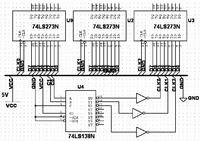bhavrana
Newbie level 3

bipolar stepper circuit
Need Help Plz help me out regarding this..I have to submit minor project for this i've thought of Robotic arm.
It requires 5 stepper motors. So Plz help me out..
Need Help Plz help me out regarding this..I have to submit minor project for this i've thought of Robotic arm.
It requires 5 stepper motors. So Plz help me out..



